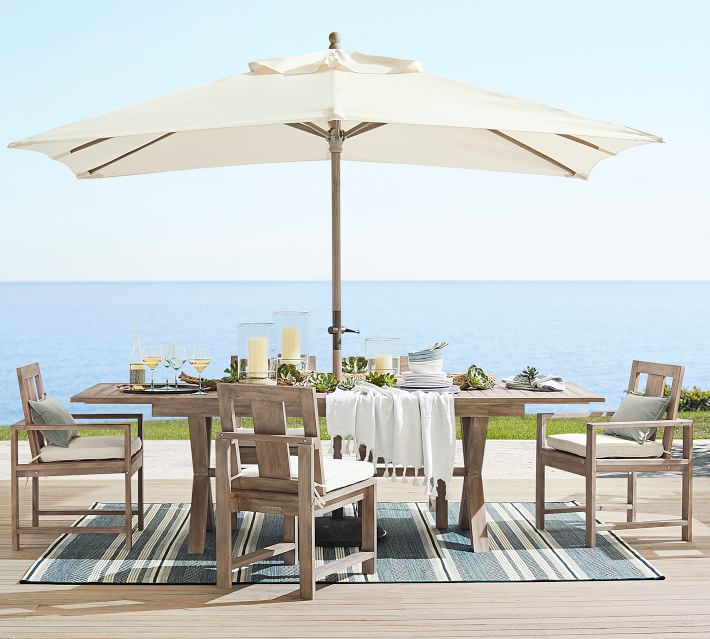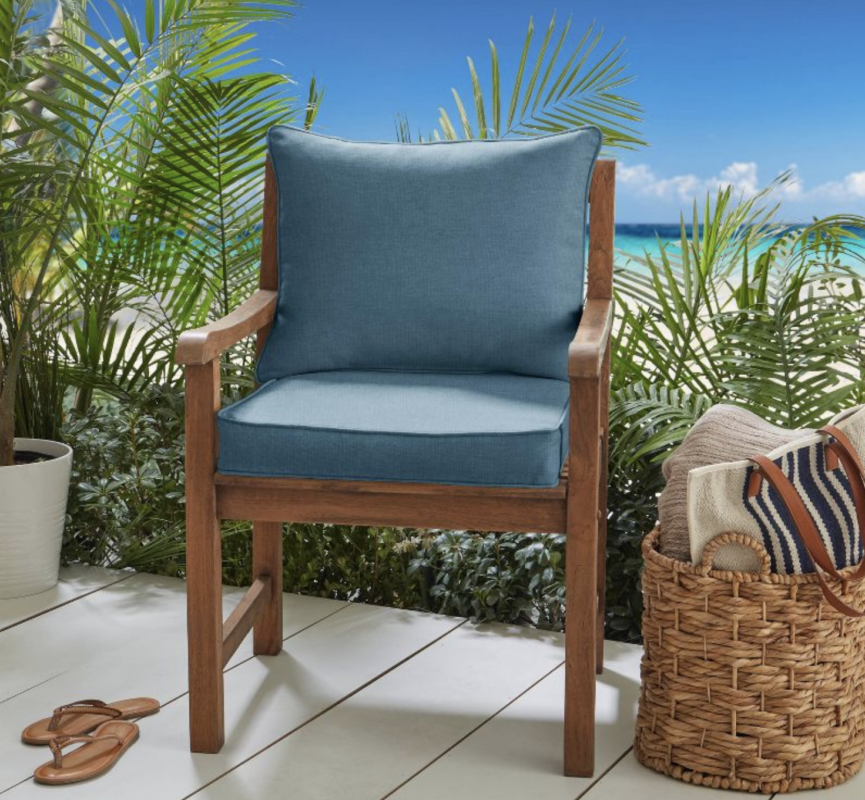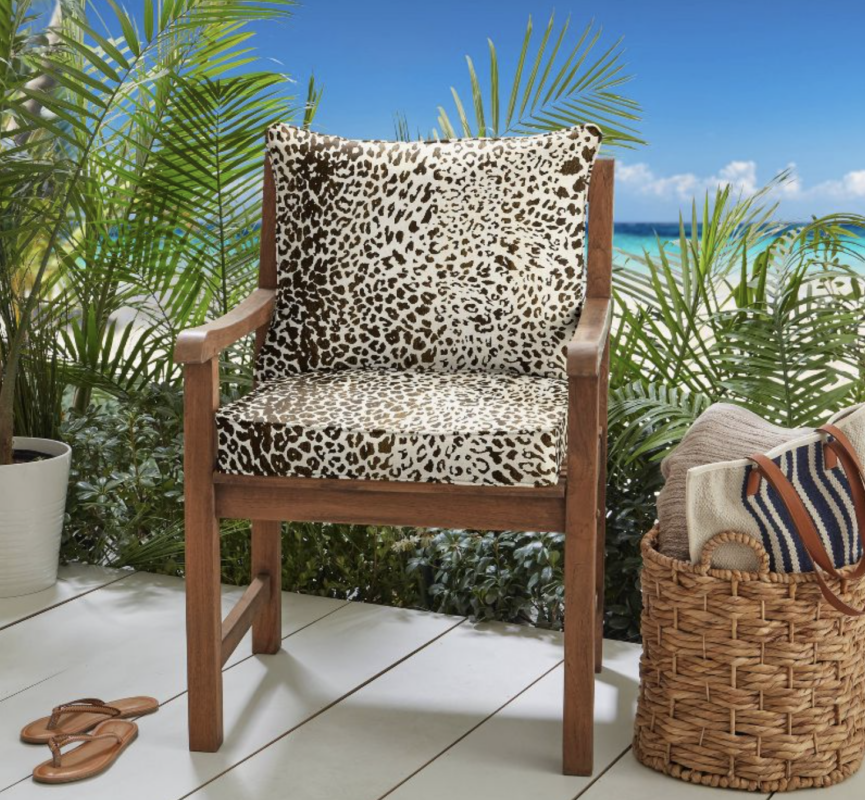We’ve covered a lot in the non-toxic furniture category, including upholstered furniture like sofas. This has led me down a rabbit hole of all of the different branded “performance” fabrics on the market today… Sunbrella, Solarium, Outdura—oh, my!
You’ll often find these types of fabrics in outdoor furniture and other products because their main selling point is that they’re very durable and weather-resistant. However, you’ll also find these fabrics used for indoor furniture as well.
But what are these fabrics even made of? Are they safe for your family? Let’s get to it.
Table of Contents
- What is Sunbrella Fabric Made Of?
- What is Sunbrella Fabric Used For?
- Benefits of Sunbrella Fabric
- Is Sunbrella Fabric Eco-Friendly?
- Is Sunbrella Fabric Non-Toxic? (Pros & Cons)
- Sunbrella Safety (The Pros)
- Sunbrella Safety (The Cons)
- TL;DR: So Can I Feel Safe Buying Products With Sunbrella Fabric or Not?
- How Does Sunbrella Compare to Other Similar Fabrics?
- Other F.A.Q.s About Sunbrella Fabric
- Conclusion
Featured Image Credit: West Elm
What is Sunbrella Fabric Made Of?
Sunbrella is a type of branded fabric that’s made out of acrylic.
Even though it seems like it’s rather new to the market, it’s actually been around for over 30 years now.
Sunbrella (along with other similar types of fabrics) is made out of 100% solution-dyed acrylic, which means the actual fibers are dyed all the way through. The alternative to solution-dying is called piece-dying, which is where the whole product is dyed after it’s assembled. Solution-dyed products and materials result in color that goes all the way to the core, whereas piece-dyed products are basically just dyed on the outer layer.
As you can imagine, solution-dyed fabrics can usually hold up much better to the wear and tear of the outdoor elements (UV rays, water, wind, etc.). This is why they’re commonly used for things like outdoor furniture, patio umbrellas, outdoor rugs, and boat covers.
But as I mentioned, solution-dyed fabrics like Sunbrella are also used for indoor furniture, too, since they can stand up well against the wear and tear of kids, pets, spills, and stains.

What is Sunbrella Fabric Used For?
Sunbrella is one of the leading brands for acrylic outdoor fabrics. They’re used by furniture manufacturers all over the world. Some of the different products you can find using Sunbrella fabrics are:
- Cushions for upholstered outdoor furniture
- Outdoor patio accessories (umbrellas, rugs, pillows, etc.)
- Upholstered indoor furniture (like sofas)
- Boat covers and other marine fabrics
- Hot tub covers, pool floats, etc.
Benefits of Sunbrella Fabric
There’s a reason Sunbrella has become so popular—it has a lot going for it in terms of “performance.” Here are some of the main selling points of this fabric:
- It’s resistant to water, mold, and bacterial growth.
- It’s strong and durable (said to be able to last an estimated 10 years of outdoor use).
- The color is fade-resistant.
- A lot of different colors and patterns are available.
- It’s pretty affordable.
- It’s easy to clean.
- It comes with several certifications indicating a degree of eco-friendliness and chemical safety (more on that below!).
Is Sunbrella Fabric Eco-Friendly?
In many ways, Sunbrella cannot be considered eco-friendly since it’s made from acrylic, which is a plastic material that is not renewable or biodegradable. A lot of Sunbrella fabric is also finished with PFAS chemicals, which build up in the environment and can cause problems to ecosystems, animals, and humans. (We’ll talk about that more in a minute.)
In other ways, however, Sunbrella might be considered more eco-friendly when compared to other types of fabrics.
The first thing to note is that more durable and long-lasting materials and products tend to be more planet-friendly simply in the fact that they help to keep products out of landfills and reduce the number of resources needed to make new products more frequently.
Second, Sunbrella has a couple of different recycling programs. One involves their “Renaissance Yarns,” which takes the fabric waste from cutting tables and manufacturing facilities to make new yarn. They also have a “Recycle My Sunbrella” program, which allows consumers to send back their old Sunbrella fabrics to the company to be regenerated.
Lastly, Sunbrella has a few other low-waste, solar power, and wastewater reduction initiatives that they’ve put in place throughout their supply chain. Many of the fabric varieties also carry several different third-party certifications which verify a certain degree of environmental responsibility, including GREENGUARD Gold, Facts Silver, ISO 14001, and Sun Protection (by the Skin Cancer Foundation).
So in other words, when it comes to Sunbrella’s environmental footprint, it’s definitely not the best, but it’s not the worst either. If you want, you can read more about Sunbrella’s sustainability initiatives here.

Is Sunbrella Fabric Non-Toxic? (Pros & Cons)
Now let’s talk about the question that might have led you to this article in the first place: Are Sunbrella fabrics non-toxic? Are they safe for you and your family?
Unfortunately, like so many questions surrounding environmental toxins, the answer is not a simple one…
First, it’s worth noting that we tried multiple times to contact Sunbrella and get more information about their fabrics and clarify some things and we have not heard back from them. This is very disappointing because it prevents us from confidently giving you solid info about the safety of these fabrics. We hope to be able to update this article in the future if they ever get back to us.
But in the meantime, here’s what we know…
Sunbrella Safety (The Pros)
Let’s start with a few of the more positive aspects of Sunbrella fabrics with regard to toxins:
- Sunbrella upholstery fabric comes with a GREENGUARD Gold Certification, which indicates a certain level of safety with regard to indoor air pollution. (This may not be the case when it comes to non-upholstery products like umbrellas or pool covers.)
- Many of their contract fabrics have also been OEKO-TEX certified, which means the end product has been tested and verified against a list of toxic chemicals.
- Some of Sunbrella’s contract fabrics are PFAS-free certified by GreenScreen. (More on this below.)
- Many of their fabrics are also free from azo-based colorants and lead, and are also compliant with California Prop 65 and REACH.
- Additionally, these types of fabrics are generally more resistant to mold compared to some kinds of natural fabrics like cotton. This is an important factor to consider, especially for those who have CIRS or other limbic system disorders that make them more sensitive to mold.
Sunbrella Safety (The Cons)
Okay, here’s where it gets frustrating.
Did you notice that in the above list of pros, we used a lot of qualifying language like “many” and “some” and “contract”?
That’s because Sunbrella manufactures many different types of fabrics, and SOME of them are safer than others when it comes to the chemicals used.
One of the main concerns for us is the use of PFAS, or “forever chemicals.” PFAS are almost always used in outdoor fabrics in order to increase water resistance. In truth, it’s extremely difficult to find outdoor furniture, camping gear, rain jackets, and similar products without PFAS.
PFAS are also extremely toxic, linked to everything from cancer to heart disease to birth defects, and more. Not only that, but they’re persistent, meaning they don’t break down in our bodies or in the environment. They just build up over a long period of time (hence the nickname “forever chemicals”), making them even more concerning.
When it comes to Sunbrella fabrics, some of them contain PFAS and others do not.
According to their website, Sunbrella’s contract fabrics that use Assure technology are PFAS-free. So far, this is the only category that is 100% PFAS-free from Sunbrella’s collection (as far as we can tell.) Okay, that’s good news… But how are you supposed to know whether the couch or cushions (or whatever it is you want to buy) is made from that specific line of PFAS-free fabric?
Well, that’s the problem!
There’s basically no way of knowing unless you call Sunbrella and/or the retailer selling the product (like West Elm, for example, whose Sunbrella upholstered couch is pictured above) and bug them about it until they give you the answer you’re looking for with regard to that specific product or collection.
And even then, you might not even get the whole answer. As we said earlier, we’ve been unsuccessful in getting Sunbrella to respond to our questions for more info, which is a big red flag in and of itself!
This brings up another issue that you should be careful of when browsing products made with Sunbrella: greenwashing. If something says it’s free from PFOA, PFOS, PTFE, PFBS, GenX, Teflon, or some similar-looking acronym—be careful. This usually means a product is free from a specific kind of forever chemical, but not necessarily ALL of them. What you want to look for are products that are free from ALL PFAS, which would include thousands of chemicals in that family.
But what about those OEKO-TEX and GREENGUARD Gold certifications… Don’t those mean the fabrics are safe? Well, even though these labels are definitely better than nothing, they unfortunately do not indicate that a product is PFAS-free. (OEKO-TEX currently tests for a few different kinds of PFAS, but not all of them. They’ve said they’re considering transitioning to 100% PFAS-free in the coming years… We will see!)
One last thing on this point: it’s a huge pet peeve of ours when brands use the “proprietary information” excuse to hide toxins in their products. While I understand that companies have to protect their innovations from copy-cats, there are ways to do that while also being transparent with consumers, who deserve to know what’s in the products they buy.
TL;DR: So Can I Feel Safe Buying Products With Sunbrella Fabric or Not?
Here’s the summary when it comes to Sunbrella and toxins:
Many of Sunbrella’s fabrics come with several different certifications such as OEKO-TEX and GREENGUARD Gold, which do indicate a certain level of safety with regard to toxic chemicals and VOCs.
When it comes to PFAS, however, some of Sunbrella’s fabrics are PFAS-free, while others are not. (Specifically, their contract fabrics using Assure technology are PFAS-free).
The problem is that it’s extremely difficult to find out whether or not the specific product you want to buy is made using fabric from this PFAS-line. You will have to call Sunbrella and/or the retailer you’re purchasing from and ask them.
From what we can tell from our research, Sunbrella tends to be slightly better in terms of transparency, third-party certifications, and sustainability initiatives compared to similiar fabric brands such as Crypton and Outdura. So when it comes to choosing the lesser of the evils, Sunbrella seems to be the top choice.
It’s also almost always going to be a better option than the outdoor furniture you’d find at big retailers like Wayfair or Walmart. Not only does this furniture almost always contain PFAS, but they also lack many of those other safety and sustainability initiatives that Sunbrella comes with (OEKO-TEX, GREENGUARD, Prop 65, etc.)
So, although Sunbrella is far from totally “non-toxic,” if you’re looking for outdoor upholstered furniture that can hold up against the wear and tear of the weather, it does (unfortunately) seem to be one of the best options currently available on the market. We hope to see some safer options come to market in the coming years!


How Does Sunbrella Compare to Other Similar Fabrics?
As we mentioned, there are similar types of fabrics on the market, such as:
- Solarium
- Crypton
- Outdura
- Nuvella
- Perennials
- Bella Dura
- and more
We reached out to a lot of these brands to find out more about what types of chemicals they use (and don’t use) in their manufacturing process. Over the course of a couple of months, we heard back from… zero of them! Again, this is concerning because when companies are unwilling to provide answers to some relatively simple questions, it often means they have something to hide. We believe customers deserve transparency, at the very least.
Since PFAS are most often the thing that gives “performance fabrics” their “performance” qualities, we recommend assuming that these fabrics DO contain PFAS unless they say otherwise. In this case, guilty until proven innocent!
Other F.A.Q.s About Sunbrella Fabric
Is Sunbrella fabric worth the money?
Whether or not Sunbrella fabrics are worth the cost comes down to many different factors, including your personal preferences and priorities. Sunbrella does seem to be very durable (it’s supposed to be able to hold up to 10 years of heavy outdoor use), and it has some other great selling points as well. IF you can get your hands on products made with their PFAS-free line of fabrics, you will be able to get both safety and performance—which we think is probably worth the money.
Does Sunbrella Have Teflon?
“Teflon” is a kind of PFAS, a.k.a. “forever chemical.” Some Sunbrella fabrics contain PFAS or other “Teflon-like” chemicals, while others do not. Specifically, their Sunbrella Assure line is PFAS-free.
Where Can You Buy Sunbrella?
You actually might be surprised by how many retailers carry products made with Sunbrella fabrics. These include:
Conclusion
Although Sunbrella is better than other “performance fabrics” on the market when it comes to environmental and safety standards and third-party certifications, we still don’t really recommend furniture and other products made using Sunbrella because it’s really difficult to determine whether or not it’s PFAS-free. We hope to see Sunbrella expand on their PFAS-free fabrics (or eliminate them completely!) and increase transparency with customers in the coming years.




